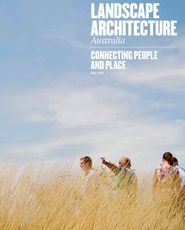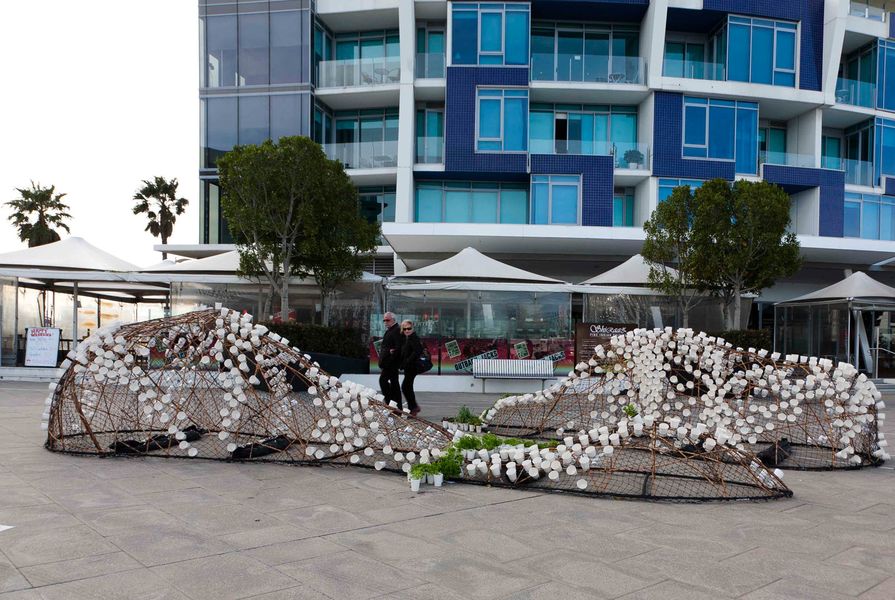Whatever you call it – participatory design, activism, spatial agency, placemaking or just design and build – there is an interest in new tactics to produce landscape architecture and architecture that is aesthetically different and which has a strong focus on attracting public engagement. These new approaches often involve the use of bright colours, recycled materials, art and pot plants. It’s actually hard to say that these are entirely new urban tactics. What we can say is that they are not the mainstream practices in Australia and that they are starting to attract attention. The tactics might involve creating something akin to an art installation or pop-up, building a project for temporary use, creating projects with a low cash cost that therefore have a high manual-labour cost, using multidisciplinary (undisciplined?) methods, or embedding political and social content in a project.
Why new tactics?
New tactics aim to develop public participation, enable bottom-up processes, promote active citizenry and create positive social impacts. Creating an alternative to globalizing forces, large inhuman scales and top-down masterplanning is key. There are theorists who describe the need for work produced in this way. Henri Lefebvre’s book Le droit à la ville [The Right to the City] (1968) comes to mind, which describes a city produced through the “synthesis of everyday life” (not by architects and planners), as does Michel de Certeau’s The Practice of Everyday Life (1980), which distinguishes the power of “tactic” from the “strategy.”1 Richard Sennett’s essay The Open City (2006) outlines the need for citizen participation in the face of brittle, global cities.2 Attempting to produce a diversity of work is a response to the context of mainstream practice and comes from a desire to contribute to the urban realm in a different way.
How landscape architecture can be an event
Here Studio is part of a movement of emerging practices that are starting to develop a process of landscape architecture or architecture where the process of design, not just the finished built form, is an event.3 To explore this concept, we offer up a small “tactical” project we completed in 2011 for the Urban Realities: Landscape Urbanism Three-Day Design Challenge, which illuminated the idea of the “event.”4
The Office of Urban Transformations Research at RMIT University selected ten teams of ten people, each a mix of students and practitioners, and gave us each $2,500, a site in Melbourne’s Docklands, a brief, the use of tools and a large shed nearby in which to build a piece of urban art.5 Our hypothesis for design was that all events need space in which to play out.
Managed by VicUrban (now Places Victoria), the urban renewal of Docklands is an important lesson, showing how leaving planning and design to developers can cost more both socially and economically.6 Our twenty-square-metre site was once the site of the Urban Reforestation project,7 a pop-up garden in the concrete-scape amid the thirty-storey residential towers of Victoria Harbour. Wanting to address the perceived problem of social dislocation and lack of community in public space, we saw the three-day challenge as an opportunity for engagement in which the design-and-build process of landscape architecture was our prop.
The first event was our own occupation of the site.8 In occupying it we discovered the traces of previous occupations: two bottle caps wedged in the boardwalk looking out to the harbour; evidence of a social event. In the afternoon, cold from the wind and wrapped in blankets, we yelled out to people to come and chat about the site and Docklands. It was confronting work – we wanted meaningful discourse! That evening, late into the night, we developed concepts around a blanket of bottle caps; this would be a refuge from the harshness of hundreds of residential windows and wind off the water. Yet we struggled with how to respond to the actual people there, i.e. the urban reality.
The next morning we distributed posters with invitations to check in on our progress at touch-points over the remaining two days. We handed out cups of herbs and constructed our project in situ so people could see and start conversations with us (“What are you doing here?” “What do you think of what we are doing?” “What’s your name?” “Do you live here?”) and, importantly, with each other.
Day three, in an environment replete with the sound of bottle caps (tink tink) and us in our brightly coloured jumpsuits cobbling together prototypes, we attracted attention. In the evening, as we threaded our bottle caps (hammers, punches and wire) on the grass, residents who we’d met previously came down and shared another beer. The weekly Docklands winter fireworks event started and hundreds of people gathered around. Some residents recognized each other and nodded, others stopped to chat about our progress or offer building tips.
We didn’t win the competition, unfortunately, and a fortnight later the only physical trace left was a few odd bottle caps. But the event in and of itself was an interesting case study of landscape-as-event, and had an immediate social impact.
How is this process different?
Let’s consider the process against the linear design process – concept design, design development, documentation, contract administration then, finally, occupation. Important decisions are made before any activity happens on site, demonstrated through drawings, images, emails and off-site meetings.
This participatory approach to the landscape has immediacy. The social space is quick and slow. Instead of occupation (the event of unlimited events) after design, community interaction begins during design. Beyond the effect of in situ, asset-based and responsive decision-making, one could argue that if occupants are given more opportunity to get to know each other through design-and-build events, they can begin to negotiate and articulate their desired occupation earlier, and with more diversity and substance.
Perhaps these urban tactics are new methods, in that they are grappling with seemingly insurmountable urban odds, through heterogenous guerilla-like actions, few resources and limited time. They might be about trying to increase active participation using the one thing that is becoming most scarce: active participation. The effect may well fit into what political theorist Chantal Mouffe calls “a micro-political practice through which participants become active agents in the force field they are facing.”9
We are often asked: “Where are the heroic images and forms – where is the architecture?” Urban tactics value chimera-outcomes of social space created, temporary places or ways of placemaking. Their form is a couple of conversations, learning a new engagement trick, the memory of something missing, residents nodding to each other as they pass each other in the street. It shifts the focus away from the expert in some respects – because we’re all doing the event, we know how to design for the event.
Further references:
Three internationally popular portfolios include Candy Chang / Civic Studio (candychang.com / civicstudio.org, c. 2010, New Orleans); Stalker (stalkerlab.org, 1995, Rome) and Muf (muf.co.uk, 1994, London). Spatial Agency (spatialagency.net, 2011, Sheffield / London) is a compendium of practices and projects focusing on other ways of doing architecture produced by researchers Nishat Awan, Tatjana Schneider and Jeremy Till. Here in Melbourne we were members of Urban Village Melbourne (urbanvillagemelbourne.net, 2008–2010) and are involved in the early days of CoDesign Studio (codesignstudio.com.au, 2010–). Both include many examples of work involving volunteers and a focus on community participation in landscape architecture.
1 “Part 2: Right to the City,” in Henri Lefebvre, Writings on cities, trans. Eleonore Kofman and Elizabeth Lebas (Oxford [UK]; Cambridge, Mass.: Blackwell, 1996), “Making Do: Uses and Tactics;” in Michel de Certeau, The Practice of Everyday Life, trans. Steven Rendall (Berkeley: University of California Press, 1984).
2 Richard Sennett, “The Open City,” in Richard Burdett et al. (eds), The Endless City (London: Phaidon Press, 2007). Sennett writes, “The city is not its own master” (290); “For cities like London and New York becoming global in scale, the problem of citizen participation is how people can feel connected to others, when […] they cannot know them. Democratic space means creating a forum for these strangers to interact” (297).
3 It’s an event when the first shovel goes in; it’s an event when the doors first open and it’s an event when the program actually happens. This series of events has already begun when someone comes up with the idea to design something and approaches an architect to make it happen.
4 See: Urban Realities blog, urbanrealitiesteams.blogspot.com (accessed 13 May 2013).
5 See: Adrian Marshall, “Urban Realities Landscape Urbanism Three-Day Design Challenge,” ArchitectureAU, 23 February 2012, architectureau.com/articles/urban-realities-landscape-urbanism-three-day-design-challenge (accessed 13 May 2013).
6 Kim Dovey, Fluid City: Transforming Melbourne’s Urban Waterfront (Sydney: University of New South Wales Press, 2005), chapters 7 and 8.
7 See: Urban Reforestation website, urbanreforestation.com (accessed 13 May 2013).
8 We thought of “occupations” and “site constructions”; see Jonathan Hill (ed.), Occupying Architecture: Between the Architect and the User (London: Routledge, 1998) and Andrea Kahn, “Overlooking: A Look at How We Look at Site or … Site as ‘Discrete Object’ of Desire,” in Katerina Rüedi, Sarah Wigglesworth and Duncan McCorquodale (eds), Desiring Practices: Architecture, Gender and the Interdisciplinary (London: Black Dog Publishing, 1996).
9 Markus Miessen and Chantal Mouffe, “Violating Consensus: Markus Miessen interviews Chantal Mouffe,” in Mario Ballesteros (ed.), Verb crisis (Barcelona: Actar, 2008), 170.
Source

Discussion
Published online: 26 Feb 2014
Words:
Michelle Emma James,
Ammon Beyerle
Issue
Landscape Architecture Australia, August 2013
















